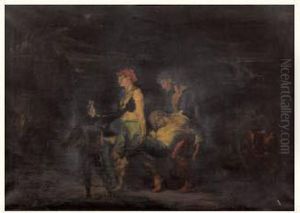Jacques Leonard Maillet Paintings
Jacques Léonard Maillet was a French sculptor and medallist born on October 12, 1827, in La Châtre, a small town in the Indre department of central France. He is often remembered for his contributions to the neoclassical tradition, which dominated European art in the late 18th and early 19th centuries. Maillet's works are characterized by their meticulous attention to detail, harmonious proportions, and a profound sense of classical beauty, reflecting the influence of ancient Greek and Roman art.
Maillet pursued his artistic training at the École des Beaux-Arts in Paris, where he was a student of David d'Angers, a prominent French sculptor known for his monumental works and portrait busts. Under David's guidance, Maillet honed his skills in sculpture and developed a keen appreciation for the ideals of neoclassicism, which sought to revive the art and culture of antiquity. His dedication and talent earned him several awards and scholarships, including the prestigious Prix de Rome in 1851. This accolade afforded him the opportunity to study at the French Academy in Rome, Villa Medici, where he immersed himself in the study of classical art and architecture.
During his time in Rome, Maillet produced several notable works that garnered attention and acclaim upon his return to France. Among his most celebrated sculptures are allegorical figures, mythological scenes, and portrait busts of distinguished contemporaries. His mastery of form and expression made him a sought-after sculptor for public monuments and private commissions across France.
Despite his success, Maillet maintained a relatively low profile, focusing on his art rather than seeking public recognition. He was, however, a respected member of the artistic community and participated in numerous exhibitions, including the Paris Salon, where his works were regularly displayed and praised for their artistic merit.
Jacques Léonard Maillet's contributions to French sculpture are marked by his adherence to classical ideals and his ability to infuse his works with a sense of timeless beauty. He passed away on July 26, 1894, in Paris, leaving behind a legacy that continues to be appreciated by art historians and enthusiasts for its elegance and refinement.
